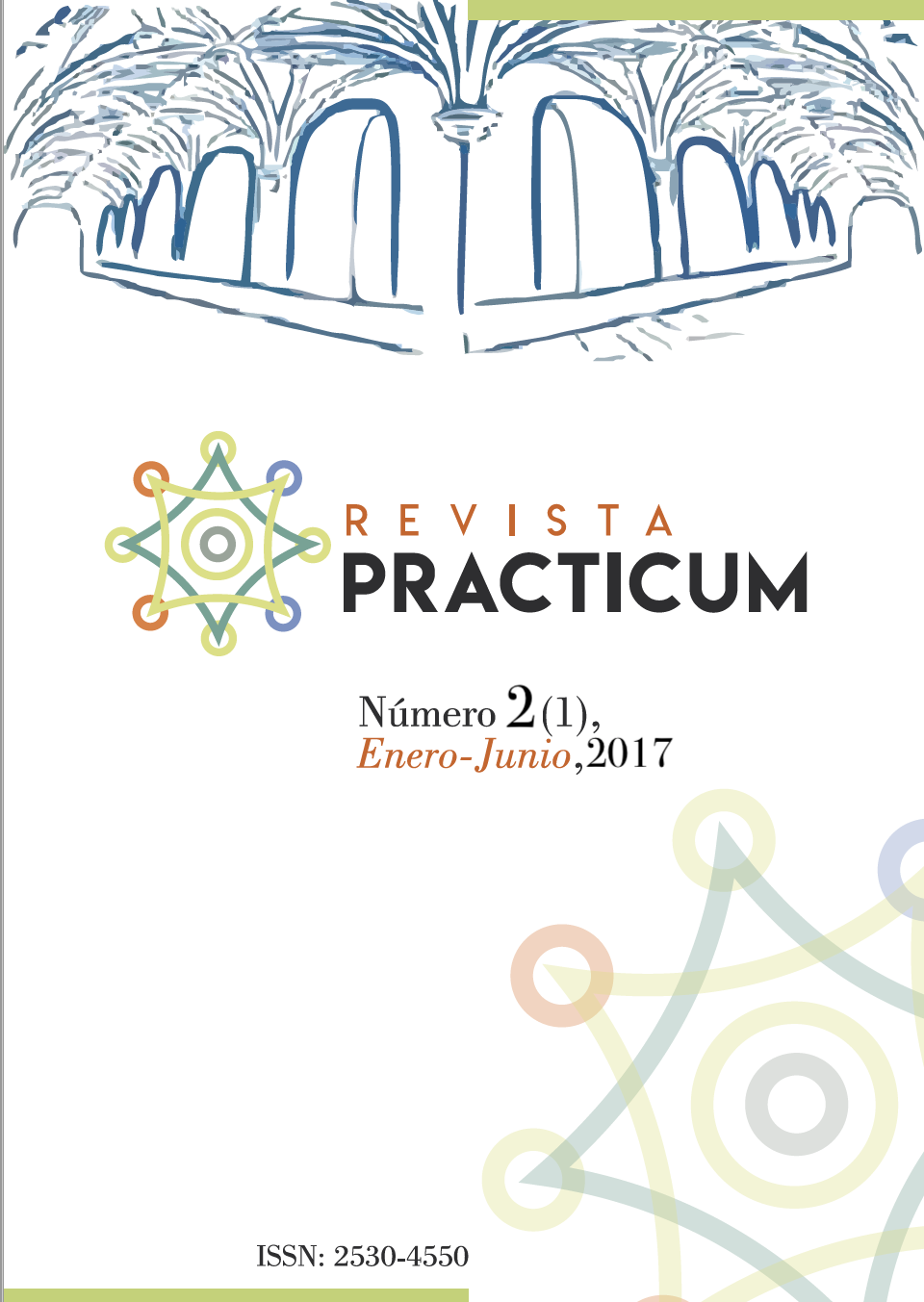Grado de satisfacción, utilidad y validez de la evaluación con rúbricas electrónicas durante el prácticum.
DOI:
https://doi.org/10.24310/RevPracticumrep.v2i1.8265Palabras clave:
Satisfacción, Evaluación, Prácticum, Rúbricas, Estudiantes de magisterio, Evaluación con rúbricas electrónicasResumen
El propósito de este estudio es conocer las opiniones de los futuros docentes ante el empleo de las e-rúbricas durante el prácticum. Con el fin de conocer y comprender sus opiniones analizamos las variables de grado de satisfacción, utilidad y validez, así como el potencial grado de recomendación a otros tras el uso de dicho instrumento. Los datos se obtienen de un cuestionario ad hoc diseñado para este fin. La muestra está formada por 29 estudiantes del Prácticum I (2016/2017) de los Grados de Educación Infantil y Primaria de la Universidad de Granada (España). Se seleccionan dos grupos de prácticum: uno experimental y otro control, para comprobar las diferencias entre el grupo que empleó la e-rúbrica durante su período de prácticas y el que no. Tras los datos obtenidos, podemos concluir que los futuros docentes han valorado positivamente el uso de la e-rúbrica, pues consideran que les ha ayudado a reflexionar sobre sus habilidades adquiridas y el proceso desarrollado. Es necesario continuar investigando ya que se ha tratado de un estudio exploratorio. Las rúbricas electrónicas pueden considerarse de utilidad para mejorar los procesos de evaluación del período de prácticas.
Descargas
Métricas
Publicación Facts
Perfil de revisores N/D
Información adicional autores
Indexado: {$indexList}
-
Indexado en
- Sociedad Académica/Grupo
- N/D
- Editora:
- Universidad de Málaga
Citas
Andrade, H., & Du, Y. (2005). Student perspectives on rubric-referenced assessment. Practical Assessment, Research and Evaluation, 10(3).
Andrade, H. L., Du, Y., &., & Mycek, K. (2010). Rubric-referenced self-assessment and middle school students’ writing. Assessment in Education: Principles, Policy & Practice, 17(2), 199-214.
Auvinen, T. (2011, November). Rubyric. InProceedings of the 11th Koli Calling International Conference on Computing Education Research,(pp. 102-106). Koli, Filand. doi: 10.1145/2094131.2094152
Atkinson, D., & Lim, S. L. (2013). Improving assessment processes in Higher Education: Student and teacher perceptions of the effectiveness of a rubric embedded in a LMS. Australasian Journal of Educational Technology, 29(5), 651-666. doi: 10.14742/ajet.526
Boud, D., Lawson, R., & Thompson, D. G. (2013). Does student engagement in self-assessment calibrate their judgement over time?. Assessment & Evaluation in Higher Education, 38(8), 941-956. doi: 10.1080/02602938.2013.769198
Casaló, L. V., Flavián, C., &Guinalíu, M. (2012). Redes sociales virtuales desarrolladas por organizaciones empresariales: antecedentes de la intención de participación del consumidor. Cuadernos de Economía y Dirección de la Empresa, 15(1), 42-51. doi: 10.1016/j.cede.2011.06.003
Cebrián-de-la-Serna, M., Serrano-Angulo, J, & Ruiz-Torres, M. (2014). Las eRúbricas en la evaluación cooperativa del aprendizaje en la Universidad. Comunicar,22(43), 153-161.
Davis, F. D. (1989). Perceived usefulness, perceived ease of use, and user acceptance of information technology. MIS quarterly, 13 (3), 319-340. doi: 10.2307/249008
Fry, S. A. (1990). Implementation and evaluation of peer marking in higher education. Assessment and evaluation in higher education, 15(3), 177-189. doi: 10.1080/0260293900150301
Hoepfl, M. (2007). Alternative classroom assessment tools and scoring mechanisms. Assessment of technology education: Council of technology teacher education 56th yearbook, 65-86.
Gallego-Arrufat, M. J., & Raposo-Rivas, M. (2014). Compromiso del estudiante y percepción del proceso evaluador basado en rúbricas. REDU. Revista de Docencia Universitaria, 12(1), 197-215. doi:10.4995/redu.2014.6423
Grisaffe, D. B. (2007). Questions about the ultimate question: conceptual considerations in evaluating Reichheld's net promoter score (NPS). Journal of Consumer Satisfaction, Dissatisfaction and Complaining Behavior, 20, 36-53.
Jonsson, A., & Svingby, G. (2007). The use of scoring rubrics: Reliability, validity and educational consequences.Educational research review,2(2), 130-144. doi: 10.1016/j.edurev.2007.05.002
Legris, P., Ingham, J., & Collerette, P. (2003). Why do people use information technology? A critical review of the technology acceptance model. Information & management,40(3), 191-204. doi: 10.1016/S0378-7206(01)00143-4
Moskal, B. M., & Leydens, J. A. (2000). Scoring rubric development: Validity and reliability. Practical assessment, research & evaluation, 7(10), 71-81.
Padilla Meléndez, A., &Garrido Moreno, A. (2006). El uso de tecnologías basadas en Internet para el aprendizaje: Un estudio exploratorio en el contexto del modelo de aceptación de la tecnología. Investigaciones europeas de dirección de la empresa (IEDEE), 12(2), 217-230.
Panadero, E., Romero, M., & Strijbos, J. W. (2013). The impact of a rubric and friendship on peer assessment: Effects on construct validity, performance, and perceptions of fairness and comfort. Studies in Educational Evaluation,39(4), 195-203. doi:10.1016/j.stueduc.2013.10.005
Panadero, E., & Romero, M. (2014). To rubric or not to rubric? The effects of self-assessment on self-regulation, performance and self-efficacy.Assessment in Education: Principles, Policy & Practice, 21(2), 133-148. doi:10.1080/0969594X.2013.877872
Panadero, E., & Brown, G. T. (2017). Teachers’ reasons for using peer assessment: positive experience predicts use. European Journal of Psychology of Education,32(1), 133-156.
Park, S. Y. (2009). An analysis of the technology acceptance model in understanding university students' behavioral intention to use e-learning. Educational technology & society,12(3), 150-162.
Pérez-Torregrosa, A.B.,Gutiérrez-Santiuste, E., & Gallego-Arrufat, M.J. (2016, september). Autoevaluación con e-rúbrica en practicum: construcción y validación del instrumento. En Pedro, N., Pedro, A., Filipe Matos, J., Piedade, J., & Fonte, M. (Eds.), Digital Technologies & Future School Atas do IV Congresso Internacional TIC e Educação 2016 (pp. 387-393). Lisboa: Instituto de Educação da Universidade de Lisboa.
Perrone, M. y Propper, F. (Eds.). (2007). Satisfacción. En Perrone Diccionario de educación. pp.339-340.Buenos Aires: Alfagrama.
Prins, F. J., Sluijsmans, D. M., Kirschner, P. A., & Strijbos, J. W. (2005). Formative peer assessment in a CSCL environment: A case study.Assessment & Evaluation in Higher Education, 30(4), 417-444. doi:10.1080/02602930500099219
Raposo-Rivas, M., & Gallego-Arrufat, M. J. (2016). University Students' Perceptions of Electronic Rubic-Based Assessment. Digital Education Review, (30), 220-233.
Reddy, Y. M., & Andrade, H. (2010). A review of rubric use in higher education. Assessment & evaluation in higher education, 35(4), 435-448. doi:10.1080/02602930902862859
Reichheld, F. F. (2003). The one number you need to grow. Harvard business review, 81(12), 46-55.
Rezaei, A. R., & Lovorn, M. (2010). Reliability and validity of rubrics for assessment through writing. Assessing writing,15(1), 18-39. doi: 10.1016/j.asw.2010.01.003
Roblyer, M. D., & Wiencke, W. R. (2004). Exploring the interaction equation: Validating a rubric to assess and encourage interaction in distance courses. Journal of Asynchronous Learning Networks, 8(4), 24-37.
Sánchez, M. J., Martín, F. A., & Villarejo, F. (2016). El modelo TAM y la enseñanza superior. Una investigación del efecto moderador del sexo. Revista Española de Pedagogía,238, 459-478.
Selim, H. M. (2003). An empirical investigation of student acceptance of course websites. Computers & Education, 40(4), 343-360. doi: 10.1016/S0360-1315(02)00142-2
Serrano Angulo, J., & Cebrián Robles, D. (2014). Usabilidad y Satisfacción de la e-Rúbrica. Revista de Docencia Universitaria, 12(1), 177-195.
Topping, K. J., Smith, E. F., Swanson, I., & Elliot, A. (2000). Formative peer assessment of academic writing between postgraduate students. Assessment & Evaluation in Higher Education, 25(2), 149-169. doi: 10.1080/713611428
Teo, T., Lee, C. B., Chai, C.S., & Wong, S. L. (2009). Assessing the intention to use technology among pre-service teachers in Singapore and Malaysia: A multigroup invariance analysis of the Technology Acceptance Model (TAM). Computers & Education,53(3), 1000-1009. doi:10.1016/j.compedu.2009.05.017
Descargas
Publicado
Cómo citar
Número
Sección
Licencia
La aceptación de la obra conlleva por parte del autor/a ceder a la Revista Prácticum en exclusiva los derechos de reproducción, distribución y venta de su obra en todo el mundo, tanto en formato digital como de papel, CD-rom, etc.
Igualmente los autores/as cederán a la Revista Prácticum los derechos de difusión, comunicación pública en internet y redes informáticas, buses de datos, como cualquier otro portal o dispositivo electrónico para consultas online de sus contenidos y extractos, y bajo las condiciones del portal, repositorios o la base de datos donde se halle la obra.
La Revista Prácticum anima a los autores la publicación y difusión de sus artículos y obras en sus páginas web personales, equipos de investigación, los repositorios institucionales y bases de datos científicas.
Todos los contenidos publicados en Revista Practicum están sujetos a la licencia Creative Commons Reconocimento-NoComercia-Compartirigual 4.0 cuyo texto completo puede consultar en <http://creativecommons.org/licenses/by-nc-sa/4.0>











8.png)








